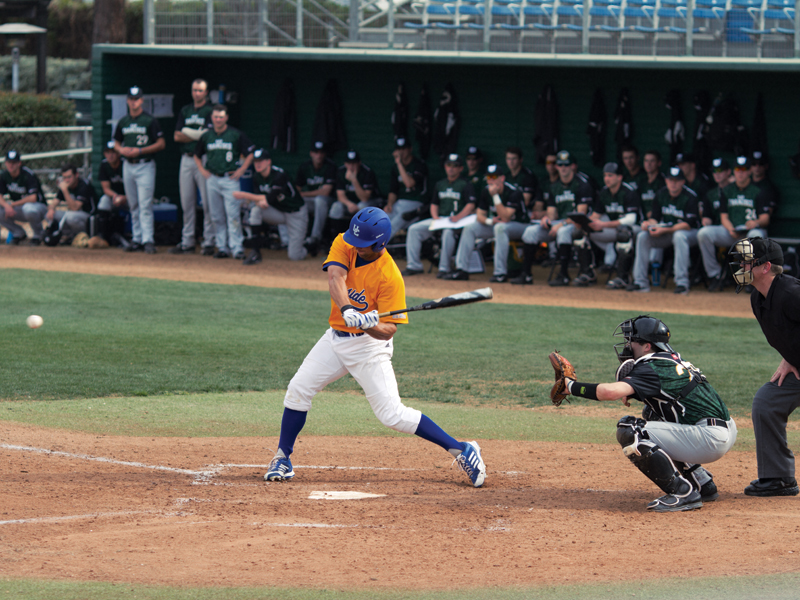
UCR psychologists Aaron Seitz, Daniel Ozer and Jenni Deveau launched a one-year vision-based study, which improved the performance of UCR baseball players, who received 41 additional runs and four additional wins throughout the season.
In 2013, 19 of 37 UCR baseball players who participated in games saw a 31 percent improvement in visual acuity over the 18 who did not. Participants used a publicly available app for the iPad developed by Seitz, called UltimEyes, to play 30 25-minute games that involved clicking on low-contrast targets. The targets are a variety of Gabor stimuli. By searching for them, people who use the app are training themselves to look for targets more efficiently, thereby improving long-distance vision.
Seitz says the training is based on 30 years of research in the field of perceptual learning, which focuses on the visual cortex, the part of the brain that controls vision rather than the eyes and ocular muscles. By doing so, the training allows the brain to process targets more efficiently, and through practice over time, improves the ability to create clearer visions at further distances. In contrast, previous games designed to improve eyesight (which focus on the eye instead of the brain) have resulted in specific improvements for that particular game, but were not applicable to real-life scenarios.
The research by Seitz was able to reduce the team’s number of strikeouts by 4.4 percent. More practically, the training also produced other vision improvements. After completing the vision-training program, some players improved to 20/7.5 vision compared to the standard 20/20. This means that they are able to view an object 20 feet away as clearly as a normal person would view the same object from 7.5 feet away.
In regards to in-game improvement, the research showed that the improvements were at least three times greater than the rest of the National Collegiate Athletic Association (NCAA) Division I in batting average, slugging percentage, on-base percentage, walks and strikeouts. With the help of the training exercises, the baseball team clocked in four to five additional wins, as determined by the Pythagorean Winning Percentage formula, a sabermetric tool that computes wins and losses based on the number of runs scored and runs allowed.
While the research appears successful so far, it is still in progress. “First, this is improved vision, however it doesn’t fix the eye. Thus if focus is not ideal, there is a stigmatism, a scotoma (and) the brain can learn to do the best with what it is given, but the problem with the input will remain.” Seitz said in a Reddit post in response to a question of whether this was improved vision or acuity.
The study also notes that a possible drawback to the training includes inducing reactions without actually seeing anything. According to a previous study done by Seitz that intended to improve perception, “subjects (after training) not only showed enhanced performance when tested with the motion direction of the trained stimulus but also often reported seeing dots moving in the trained direction when no stimulus was displayed.”
Researchers are also unsure of why the vision enhancements are more pronounced in some people than in others, and of the duration of vision improvement.
Seitz and his colleagues will continue the training with the softball team this year as well. However, the overall goal is to help improve vision for everyone in their daily lives. “We use vision for many daily tasks, including driving, watching TV, or reading,” Deveau told UCR Today. “This type of vision training can help improve not only sports performance, but many of these activities in non-athletes as well.”
Seitz further commented on the importance of vision training and seeks to expand their research in the future. “Vision training can help with reading, memory training can help us more efficiently process information, there is a lot of promise.” Seitz said. “Together with Victor Zordon (in computer science) we are training to set up a Brain Game Center at UCR to further these studies.”
“I didn’t think we would see as much of an improvement as we did,” UCR Baseball Coach Doug Smith told UCR Today. “Our guys stopped swinging at some pitches and started hitting at others. Their average strikeout total went down and batting went up.” The research also improved the players’ overall offensive performance on the diamond as well.
“Everyone is looking for an edge to be that little bit better,” Smith added to the same interview. ”Our guys are more confident now when they come to the plate.”
The study, “Improved vision and on-field performance in baseball through perceptual learning,” was published on Feb. 17 in “Current Biology.” Seitz has previously published studies on perception and the capabilities of the eye.








